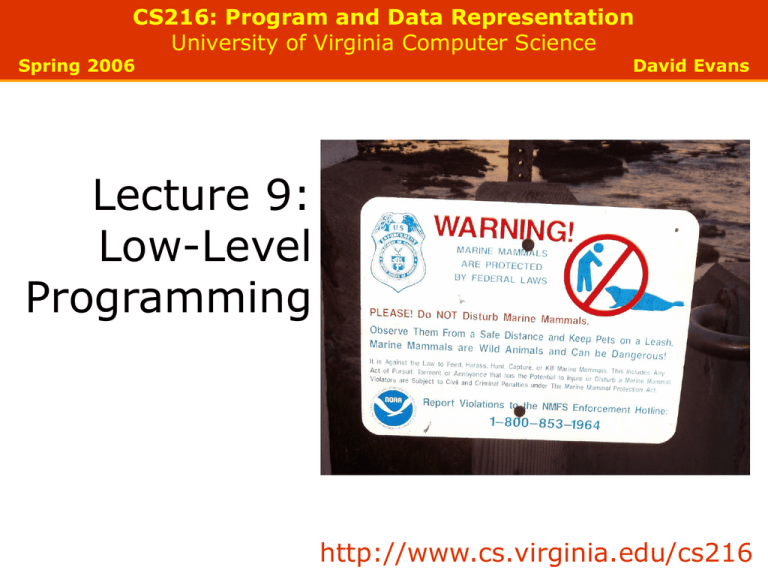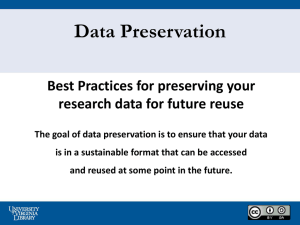Class 9: Low-Level Programming
advertisement

CS216: Program and Data Representation
University of Virginia Computer Science
Spring 2006
David Evans
Lecture 9:
Low-Level
Programming
http://www.cs.virginia.edu/cs216
Menu
• Complexity Question
• Low-Level Programming
Exam 1
Out Wednesday, Due Monday, 11:01AM
Covers everything through Lecture 8
Expect questions on:
order notation, algorithm analysis, lists,
trees, recursive programming, dynamic
programming, greedy algorithms
Not on complexity classes (Lecture 8)
UVa CS216 Spring 2006 - Lecture 9: Low-Level Programming
2
Problem Classes if P NP:
Sequence
Alignment: O(n2)
NP
P
NP-Complete
Note the
NPComplete
class is a
ring – others
are circles
Interval
Scheduling:
(n log n)
O(n)
3SAT
UVa CS216 Spring 2006 - Lecture 9: Low-Level Programming
How many problems
are in the (n) class?
infinite
How many problems
are in P but not
in the (n) class?
infinite
How many problems
are in NP but not
in P?
infinite
Subset Sum
3
Is it ever useful to be
confident that a problem is
hard?
UVa CS216 Spring 2006 - Lecture 9: Low-Level Programming
4
Knapsack Cipher
[Merkle & Hellman, 1978]
• Public Key: A = {a1, a2,…,an}
– Set of integers
• Plain Text: x1,…xn
xi = 0 or 1
• Cipher Text:
n
s xiai
i 1
UVa CS216 Spring 2006 - Lecture 9: Low-Level Programming
5
Subset Sum is Hard
• Given s and A it is NP-Complete to
find a subset of A that sums to s
• Need to make decrypting each (for
recipient with the “private key”)
UVa CS216 Spring 2006 - Lecture 9: Low-Level Programming
6
Superincreasing Set
• Pick {a1, a2,…,an} is a superincreasing
sequence
i 1
ai aj
j 1
How hard is subset sum if A
is superincreasing?
UVa CS216 Spring 2006 - Lecture 9: Low-Level Programming
7
Knapsack Ciphers
• Private Key = {p1, p2,…,pn}
– A superincreasing sequence
– Values M and W:
n
M bi
i 1
GCD( M ,W ) 1
• Public Key = {a1, a2,…, an}
ai (biW ) modM
UVa CS216 Spring 2006 - Lecture 9: Low-Level Programming
8
Flawed Security Argument
• Subset Sum is NP-Complete
• Breaking knapsack cipher involves
solving a subset sum problem
• Therefore, knapsack cipher is secure
Flaw: NP-Complete means there is no
fast general solution. Some instances
may be solved quickly.
(Note: Adi Shamir found a way of breaking
knapsack cipher [1982])
UVa CS216 Spring 2006 - Lecture 9: Low-Level Programming
9
Levels of Abstraction: Program
Real World Problem
Physical
World
Virtual
World
High-Level Program
Machine Instructions
Physical
Processor
UVa CS216 Spring 2006 - Lecture 9: Low-Level Programming
From Lecture 3
10
Crossing-Levels
Python Program
C Program
C
Python
x86 Instructions
Interprete
r
compiler
x86 Instructions
UVa CS216 Spring 2006 - Lecture 9: Low-Level Programming
11
Programming Languages
UVa CS216 Spring 2006 - Lecture 9: Low-Level Programming
12
Fortran (1954), IBM (Backus)
LISP (1957)
Algol (1958)
BASIC (1963)
CPL (1963), U Cambridge
Scheme (1975)
Combined Programming Language
Simula (1967)
BCPL (1967), MIT
Basic Combined Programming Language
ABC (~1980)
B (1969), Bell Labs Smalltalk
(1971), PARC
C (1970), Bell Labs
C++ (1983), Bell Labs Objective C
Python (1990),
Guido van Rossum
Java (1995)
UVa CS216 Spring 2006 - Lecture 9: Low-Level Programming
Programming Languages
Phylogeny (Simplified)
13
Why so many
Programming Languages?
UVa CS216 Spring 2006 - Lecture 9: Low-Level Programming
14
“Jamais Jamais Jamais” from Harmonice Musices
Odhecaton A. Printed by Ottaviano Dei Petrucci in
1501 (first music with movable type)
UVa CS216 Spring 2006 - Lecture 9: Low-Level Programming
15
“Jamais Jamais Jamais” from
Harmonice Musices Odhecaton A.
(1501)
J S Bach, “Coffee Cantata”,
BWV 211 (1732)
www.npj.com/homepage/teritowe/jsbhand.html
UVa CS216 Spring 2006 - Lecture 9: Low-Level Programming
16
Modern Music Notation
Roman HaubenstockRamati, Concerto a Tre
John Cage, Fontana Mix
http://www.medienkunstnetz.de/works/fontana-mix/audio/1/
UVa CS216 Spring 2006 - Lecture 9: Low-Level Programming
17
UVa CS216 Spring 2006 - Lecture 9: Low-Level Programming
18
Thought and Action
• Languages change the way we think
– Scheme: think about procedures
– BASIC: think about GOTO
– Algol, Pascal: think about assignments, control
blocks
– Java: think about types, squiggles, exceptions
– Python?
• Languages provide abstractions of machine
resources
– Hide dangerous/confusing details: memory
locations, instruction opcodes, number
representations, calling conventions, etc.
UVa CS216 Spring 2006 - Lecture 9: Low-Level Programming
19
Abstractions
• Higher level abstractions
– Python, Java, BASIC, …
– Easier to describe abstract algorithms
– But, cannot manipulate low-level machine
state
• How are things stored in memory?
• Opportunities for optimization lost
• Lower level abstractions
– C, C++, JVML, MSIL, Assembly, …
– Harder to describe abstraction algorithms
– Provides programmer with control over lowlevel machine state
UVa CS216 Spring 2006 - Lecture 9: Low-Level Programming
20
Biggest Single Difference:
Memory Management
• High-level languages (Python, Java)
provide automatic memory
management
– Programmer has no control over how
memory is allocated and reclaimed
– Garbage collector reclaims storage
• Low-level languages (C, Assembly)
leave it up to the programmer to
manage memory
UVa CS216 Spring 2006 - Lecture 9: Low-Level Programming
21
Fortran (1954), IBM (Backus)
LISP (1957)
Algol (1958)
BASIC (1963)
CPL (1963), U Cambridge
Scheme (1975)
Combined Programming Language
Simula (1967)
BCPL (1967), MIT
Basic Combined Programming Language
ABC (~1980)
B (1969), Bell Labs Smalltalk
(1971), PARC
C (1970), Bell Labs
C++ (1983), Bell Labs Objective C
Python (1990),
Guido van Rossum
Java (1995)
UVa CS216 Spring 2006 - Lecture 9: Low-Level Programming
Programming Languages
Phylogeny (Simplified)
22
C Programming Language
• Developed to build Unix OS
• Main design considerations:
– Compiler size: needed to run on PDP-11
with 24KB of memory (Algol60 was too big
to fit)
– Code size: needed to implement the whole
OS and applications with little memory
– Performance, Portability
• Little (if any consideration):
– Security, robustness, maintainability
UVa CS216 Spring 2006 - Lecture 9: Low-Level Programming
23
C Language
• No support for:
– Array bounds checking
– Null dereferences checking
– Data abstraction, subtyping, inheritance
– Exceptions
– Automatic memory management
• Program crashes (or worse) when
something bad happens
• Lots of syntactically legal programs
have undefined behavior
UVa CS216 Spring 2006 - Lecture 9: Low-Level Programming
24
Example C Program
void test (int x) {
while (x = 1) {
printf (“I’m an imbecile!”);
x = x + 1;
}
}
In Java:
void test (int x) {
while (x = 1) {
printf (“I’m an imbecile!”);
x = x + 1;
}
}
> javac Test.java
Test.java:21: incompatible type
found : int
required: boolean
while (x = 1) {
x = 1 assigns 1 to x, and has the value 1.
^
I’m an imbecile!
1 error
I’m an imbecile!
I’m an imbecile!
I’m an imbecile!
I’m 9:
anLow-Level
imbecile!
UVa CS216 Spring 2006 - Lecture
Programming
25
Weak type checking:
In C, there is no boolean type.
Any value can be the test expression.
Fortran (1954)
LET
:=
Algol (1958)
CPL (1963), U Cambridge
:=
Combined Programming Language
BCPL (1967), MIT
:=
Basic Combined Programming Language
B (1969), Bell Labs
=
C (1970), Bell Labs =
C++ (1983), Bell Labs
Java (1995), Sun
=
=
UVa CS216 Spring 2006 - Lecture 9: Low-Level Programming
26
= vs. :=
Why does Python use = for assignment?
• Algol (designed for elegance for presenting
algorithms) used :=
• CPL and BCPL based on Algol, used :=
• Thompson and Ritchie had a small computer to
implement B, saved space by using = instead
• C was successor to B (also on small computer)
• C++’s main design goal was backwards compatibility
with C
• Python was designed to be easy for C and C++
programmers to learn
UVa CS216 Spring 2006 - Lecture 9: Low-Level Programming
27
C Bounds Non-Checking
int main (void) {
int x = 9;
char s[4];
}
gets(s);
printf ("s is: %s\n“, s);
printf ("x is: %d\n“, x);
Note: your results
may vary
(depending on
machine, compiler,
what else is
running, time of
day, etc.). This is
what makes C fun!
> gcc -o bounds bounds.c
> bounds
abcdefghijkl
(User input)
s is: abcdefghijkl
x is: 9
> bounds
abcdefghijklm
s is: abcdefghijklmn
x is: 1828716553
= 0x6d000009
> bounds
abcdefghijkln
s is: abcdefghijkln
x is: 1845493769 = 0x6e000009
> bounds
aaa... [a few thousand characters]
crashes shell
UVa CS216 Spring 2006 - Lecture 9: Low-Level Programming
28
Charge
• Wednesday: Exam 1 is out, due
Monday
• No regularly scheduled Small Hall
and office hours while Exam 1 is out
UVa CS216 Spring 2006 - Lecture 9: Low-Level Programming
29







